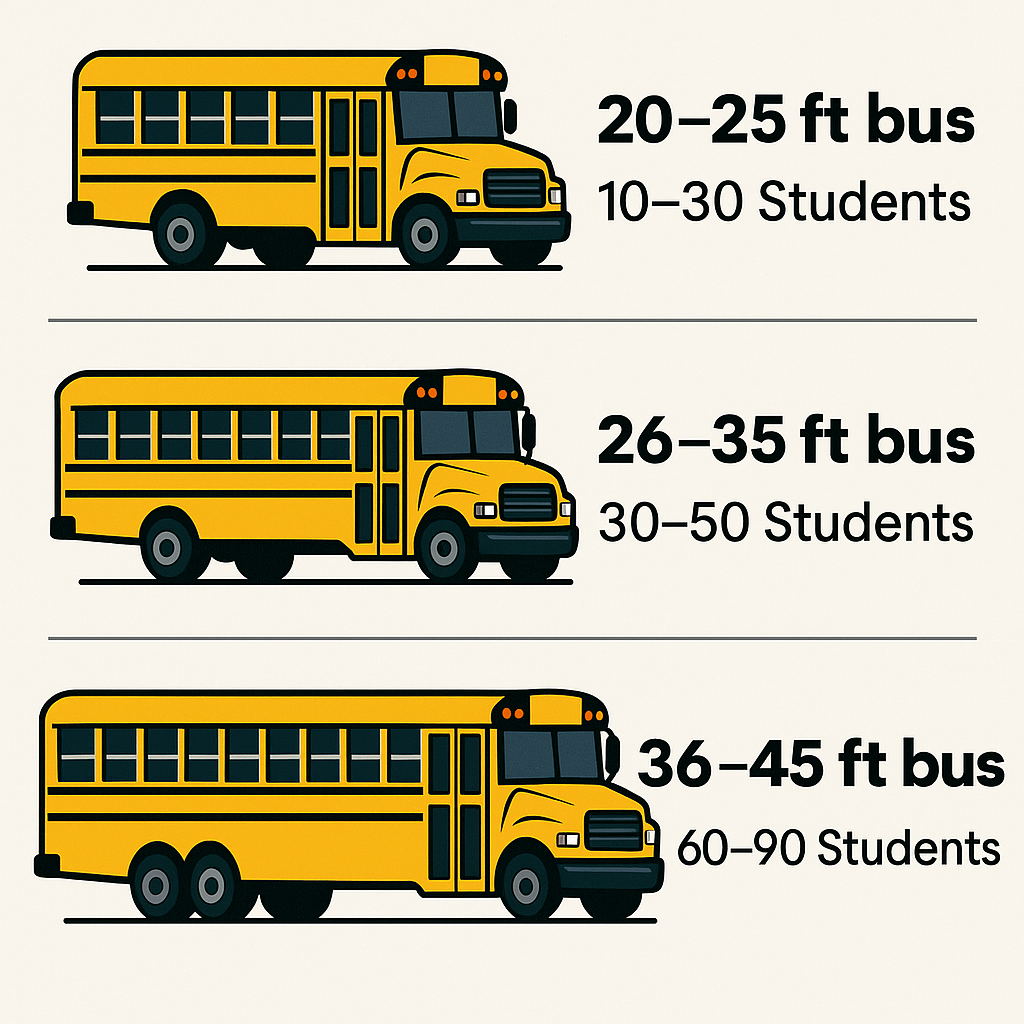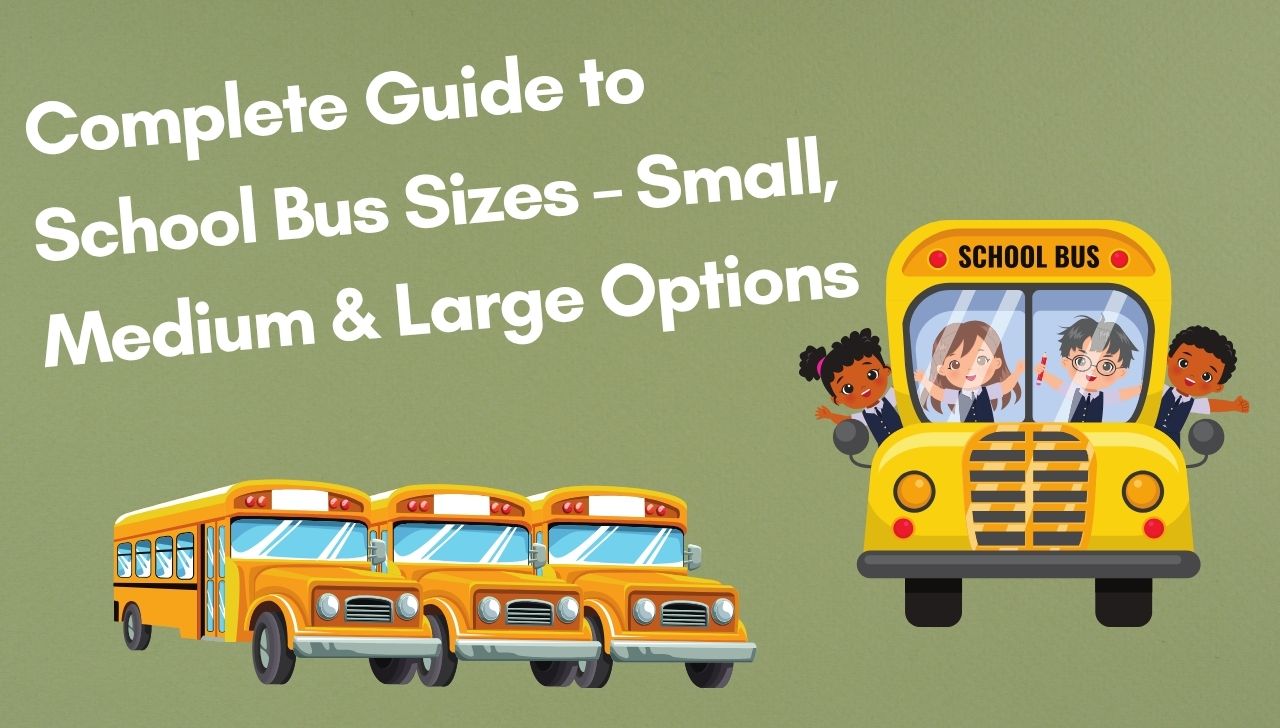When most people think of a school bus, they picture that big, bright yellow behemoth chugging down the road with kids waving from the back windows. But what many don’t realize is there’s no one-size-fits-all model when it comes to school buses. They come in different shapes, sizes, and capacities, all designed for specific needs. Why does that matter? Because choosing the wrong bus can lead to wasted resources, overcrowded routes, or even safety issues.
Whether you’re a school district administrator, a private fleet manager, or a curious parent—understanding school bus sizes helps ensure kids get to school safely and efficiently, without breaking the bank or the law.
Common School Bus Size Categories
School buses generally fall into three categories: small, mid-sized, and full-sized. These aren’t just arbitrary labels—they reflect fundamental differences in physical dimensions and passenger capacity.
- Small buses typically seat 10–30 passengers. They’re ideal for shorter routes, smaller groups, or students with special needs.
- Mid-sized buses carry between 30–50 passengers and are often used for suburban routes or areas with moderate ridership.
- Full-sized buses, the big yellow classics, can haul 60–90 kids depending on configuration. These are the workhorses of large school districts.
Each of these serves a distinct role in school transportation planning. But how do they differ beyond just size?
Find Out More : How Tall Is a Pringles Can? Learn the Height and More Fun Facts

School Bus Lengths Explained
Let’s talk numbers. School bus lengths typically range from 20 to 45 feet, depending on the model and category.
- Mini school buses (20–25 feet) are van-style or cutaway models. Short, maneuverable, and usually used for specific purposes like transporting students with disabilities or servicing narrow rural routes.
- Mid-size buses (26–35 feet): A solid middle ground. These are easier to park and drive than full-sized buses but still offer significant capacity.
- Full-size buses (36–45 feet): These are the long ones with all the bells and whistles (and seating). Commonly used in large districts with high student populations.
The longer the bus, the more kids it can carry—but the trickier it becomes to navigate tight streets, especially in older urban neighborhoods.
Passenger Capacity by Bus Size
Now, this is where things get interesting. You’d think longer bus equals more seats, right? Well, yes… but also no.
School buses are typically rated for three small children per seat. So a 72-passenger bus has 24 benches. But let’s be real—three high schoolers shoulder-to-shoulder? Not happening. That’s why real-world capacity often drops to two teens per seat or fewer for students with mobility devices.
Here’s a quick cheat sheet:
- 20–25 ft bus: 10–30 passengers
- 26–35 ft bus: 30–50 passengers
- 36–45 ft bus: 60–90 passengers
It’s also worth noting that special needs buses might have fewer seats to allow space for wheelchairs, harnesses, or medical equipment.
Overview of School Bus Types (A, B, C, D)
Beyond length and capacity, school buses are also categorized by type, designated by letters A through D. Sounds technical. Still, it’s just the industry’s way of sorting them by body style and chassis.
- Type A: These are the smallest. Built on a cutaway van chassis, they’re perfect for 10–30 passengers. Often used for special education routes.
- Type B: Slightly larger, but still pretty compact. These buses have the engine partially inside the front cabin. They’re less common these days.
- Type C: Ah yes, the classic. The conventional bus with a hood in front—what most of us rode to school. Seats up to 72 (or more).
- Type D: These are the “flat nose” buses with the engine in the rear or front. Great for high passenger volume and smoother turns in tight spaces.
Each type has trade-offs in terms of visibility, serviceability, and cost. For example, Type D buses are often used in urban environments with frequent tight turns.
Find Out More : Monster Can Dimensions Explained: Full Guide to Size and Capacity
Choosing the Right Size for School Transportation Needs
So how do districts or private schools decide which size or type to go with? It depends on the route, the students, and the budget.
Let’s break it down:
- Route type: Tight city streets? You’ll want something short and nimble. Long rural roads? Go big to minimize trips.
- Student age: Elementary kids are smaller and can fit three per seat. High schoolers? Not so much.
- Special needs: If students need lifts, wheelchairs, or aides, that will change the interior layout significantly.
- Weather conditions: Rear-engine buses might offer better traction and heat distribution in snowy regions.
- Driver availability: Believe it or not, in districts facing a driver shortage, having fewer large buses that require fewer drivers can be more practical.
It’s a puzzle, honestly. But a well-planned fleet saves time, gas, and a lot of hassle.
School Bus Size Regulations and Standards
Now let’s talk rules—because the school bus world has many of them. Each state has its own set of regulations, but most follow general federal guidelines set by the National Highway Traffic Safety Administration (NHTSA). These include:
- Passenger limits based on seat width and bus length
- Emergency exit requirements that vary by bus size
- Weight restrictions—larger buses must meet specific axle load limits
- Visibility and mirrors—required fields of vision depend on size
- Turning radius requirements to ensure road compatibility
Smaller buses may be allowed on narrower roads or to park in residential areas where full-sized buses can’t. Larger buses often require special licensing (typically a CDL with endorsements).
The bottom line? School bus sizes aren’t just about capacity—they’re about complying with a long list of safety codes and state laws.
Conclusion
Choosing the right school bus size boils down to balancing capacity, budget, and route logistics. Small buses are nimble and ideal for short routes or special needs, while medium and large ones cover more ground and carry more students. There’s no one-size-fits-all answer—but understanding your options puts you in the driver’s seat, literally and figuratively. Pick the right ride, and everything else tends to fall into place.

Suzana explores how culture, geography, and tradition influence the sizes of everyday items—from clothing to furniture. With international research experience, he brings global perspective to Sizello’s content.


Leave a Reply